Controverscial.Com
![]()
Welcome
![]()
|
Controverscial.Com
Welcome
|
|
|
Controverscial.Com
Welcome
|



![]()
During the hippy/peace era of the late 1960s the Desiderata was widely distributed in poster form as an inspirational lifestyle poem. It was made even more popular in 1971 when singer Les Crane used it to make a hit record and won a Grammy Award for the “best spoken word recording”. Later that same year it was published in the magazine Success Unlimited, which raised the issue of its history and legal copyright. Its history was subsequently traced back to “Max Ehrmann”, an American attorney and author who had originally penned and copyrighted the poem in 1927 as: “Go placidly amid the noise and haste”.
Go
placidly amid the noise and haste
and remember what peace there may be in silence
As far as possible without surrender
be on good terms with all persons
Speak your truth quietly and clearly
and listen to others
even the dull and the ignorant
they too have their story
Avoid
loud and aggressive persons
they are vexations to the spirit
If you compare yourself with others
you may become vain and bitter
for always there will be greater and lesser persons than yourself
Enjoy your achievements as well as your plans
Keep
interested in your own career, however humble
it is a real possession in the changing fortunes of time
Exercise caution in your business affairs
for the world is full of trickery
But let this not blind you to what virtue there is
many persons strive for high ideals
and everywhere life is full of heroism
Be
yourself
Especially, do not feign affection
Neither be cynical about love
for in the face of all aridity and disenchantment
it is as perennial as the grass
Take
kindly the counsel of the years
gracefully surrendering the things of youth
Nurture strength of spirit to shield you in sudden misfortune
But do not distress yourself with dark imaginings
Many fears are born of fatigue and loneliness
Beyond a wholesome discipline
be gentle with yourself
You
are a child of the universe
no less than the trees and the stars
you have a right to be here
And whether or not it is clear to you
no doubt the universe is unfolding as it should
Therefore
be at peace with God
whatever you conceive Him to be
and whatever your labors and aspirations
in the noisy confusion of life keep peace with your soul
With
all its sham, drudgery, and broken dreams
it is still a beautiful world
Be cheerful
Strive to be happy
![]()
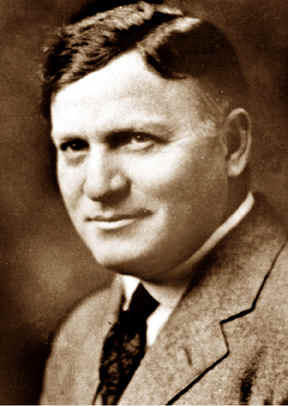
Born on the 26th
September 1872, Max Ehrmann was the youngest of five children, his Sister
Mathilda (Tillie) was the
eldest, followed by three brothers – Charles, Emil and Albert.
His father Maximilian
Ehrmann and mother Margaret Barbara Lutz Ehrmann had immigrated to the United
States in the late 1840s from Bavaria, Germany.
Initially they lived in a small one-story
brick house on North Fourth Street,
Terre Haute, Indiana, from where Max Sr. was employed as a cabinetmaker customizing
the interiors of Pullman rail carriages at the nearby Vandalia Railroad Yards.
It was from such humble beginning that the Ehrmann
family later prospered in wealth and influence.
Max Ehrmann
began his early education at the German Methodist Church and the Terre Haute
Fourth District School, from where his
English teacher, Louise Peters, inspired his passion for reading and literature.
In
his journals Max later recorded: “I
had a pleasant childhood in which my love of literature was also nurtured by my
parents. Our family evening entertainment often consisted of reading
aloud from works of Germany’s classics, and my father reciting poems from Friedrich
von Schiller,
the German poet, dramatist, philosopher and historian.”
After
graduating from High School in 1890,
Max moved on to study English at DePauw University in Greencastle, Indiana.
There he was elected into the Beta Beta chapter of the Delta Tau Delta
(an influential college fraternity founded in 1858),
he was also made student editor of the University’s newspaper, the Depauw
Weekly. About his stay at DePauw University Max recorded in his journals:
“While
there, I contracted a disease I have never shaken off.
That disease was idealism.”
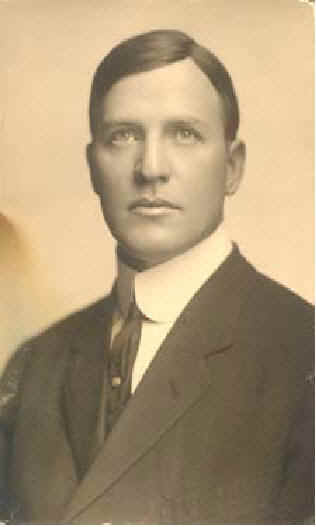
After
graduating from DePauw in 1894 with a degree in English, Max moved on to Harvard
University in Cambridge, Mass, studying Philosophy and Law.
While there he continued his association with the Delta Tau Delta and was
made editor of its national magazine The Rainbow, at the same time he wrote articles and poems for various national magazines and local dailies, such
as The Boston Herald. In 1898
he published his first book called A Farrago (a book of fiction).
Later that year after completing his Law degree and being admitted to the
American Bar Association, he was invited to run for
the Indiana legislature, however, he chose to return home to Terre Haute
and there took up a position as the Deputy State Attorney for Vigo County, Indiana.
By this time his brothers had
built a formidable family Business Empire.
Charles, the eldest who had started out as a meat packer, now owned the
Ehrmann Meat Packing Co. He then bought a Coal Mine, which became the Ehrmann Coal Co.
and to accommodate his workers he platted the community of Ehrmandale
in the nearby Nevins Township of Terre Haute.
He was also the President of the West Terre Haute State Bank and the
Central Building and Loan Association.
Meanwhile his brother Emil, who had dropped out of High
School early and worked as a travelling salesman for garment maker Charles
Zimmerman (the inventor of bib overalls), later with his brother Albert,
founded the Ehrmann Manufacturing Co. specialising in work clothing.
Housed in a purpose built three-story building at 929-933 Wabash Ave, it
soon became one of the three biggest employers in Terre
Haute’s then-booming garments industry.
Emil also bought the former site of Fort Harrison, famous for a battle
victory during the Indians Wars of 1812. Then
in disrepair, he spent a considerable sum of money restoring and improving the
property’s buildings with hopes of turning it into a National Historic park,
but sadly this never happen.
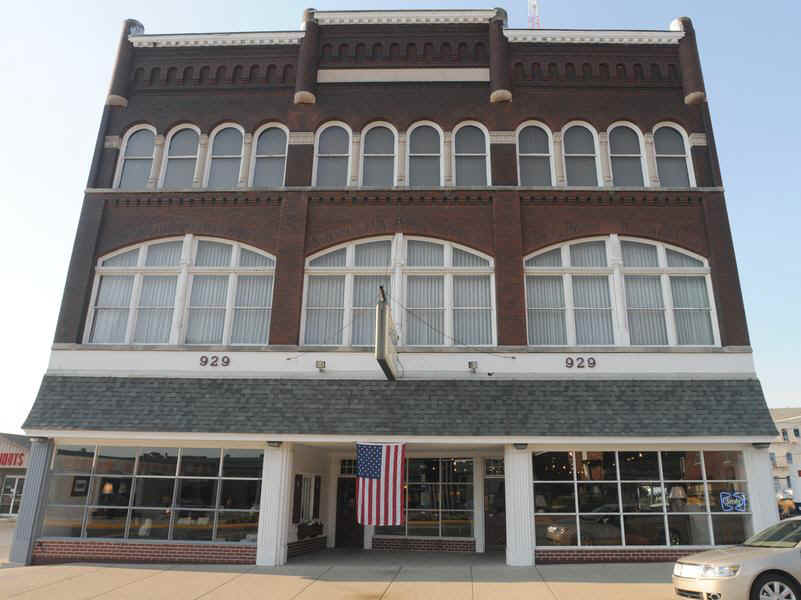
After serving two years as the Deputy
State Attorney, Max
joined his brothers growing Business Empire and worked for a number of
years as their Business Attorney and credit manager.
However his heart was never
in such work, for he was more interested in writing and philosophy, and when not
working, spent much of his time attending to the Terre Haute Literary Society.
Despite having published six books without much success, at the
age of 40, supported by his brothers who continued to helped him financially, he left the family business to
concentrate full-time on his
writing career.
As a writer and author, Max wrote more than 20 books and pamphlets, and frequently contributed essays and poems to local newspapers and national magazines. However, during his own lifetime only one of his poems gained some moderate success, A Prayer written in 1903 (below). Much later, mainly through the efforts of his late wife Bertha, the Desiderata (above) first written in 1927, gained him widespread acclaim and achieved the recognition he so deserved.
Let
me do my work each day; and if the darkened hours of despair overcome me, may I
not forget the strength that comforted me in the desolation of other times.
May I still remember the bright hours that found me walking over the silent
hills of my childhood, or dreaming on the margin of a quiet river, when a light
glowed within me, and I promised my early God to have courage amid the tempests
of the changing years.
Spare me from bitterness and from the sharp passions of unguarded moments. May I
not forget that poverty and riches are of the spirit.
Though the world knows me not, may my thoughts and actions be such as shall keep
me friendly with myself.
Lift up my eyes from the earth, and let me not forget the uses of the stars.
Forbid that I should judge others lest I condemn myself.
Let me not follow the clamour of the world, but walk calmly in my path.
Give me a few friends who will love me for what I am; and keep ever burning
before my vagrant steps the kindly light of hope.
And though age and infirmity overtake me, and I come not within sight of the
castle of my dreams, teach me still to be thankful for life, and for time's
olden memories that are good and sweet; and may the evening's twilight find me
gentle still.
This poem A Prayer, while never as famous as the
later Desiderata, has an equally interesting history.
Sometime around the turn of the century 1900, Max was staying in a hotel
while visiting friends in Columbia, South Carolina, and while there caught and
suffered with a bout of typhoid
fever. Late one sleepless night he heard the faint sound of laughter
and music coming from a dance across the street, and being far from home in a
strange environment was struck by the loneliness he felt, and so he wrote A
Prayer.
First published in 1903, a year later a framed copy of A
Prayer was hung in the Indiana State Building of the 1904 World’s Fair in
St. Louis, Missouri, from where it was later stolen.
The resulting flurry of publicity brought it to the attention of the
general public. Later in 1909, A
Prayer was read during the opening address of the United States Senate (most likely by Ulysses
Grant Baker Pierce, a Unitarian minister who served as Chaplain of the Senate
from 1909–1913). It was then printed
in the Congressional Record on the 14th of February 1909.
It was not until the late 1960s when due to the re-publication of the Desiderata,
it too was retrieved from obscurity and regained its popularity.
Toward the end of his life on the 03rd June 1945, Max married his long-time companion Bertha Pratt King, founder of the King Classical School in Terre Haute. Sadly however, just three months later he passed away on the 09th September 1945, and was later interred at the Highland Lawn Cemetery in Terre Haute.
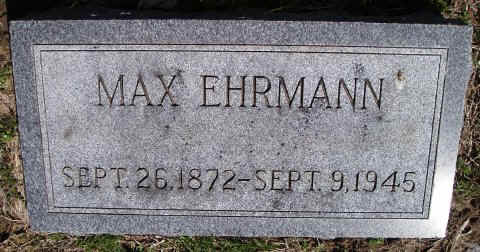
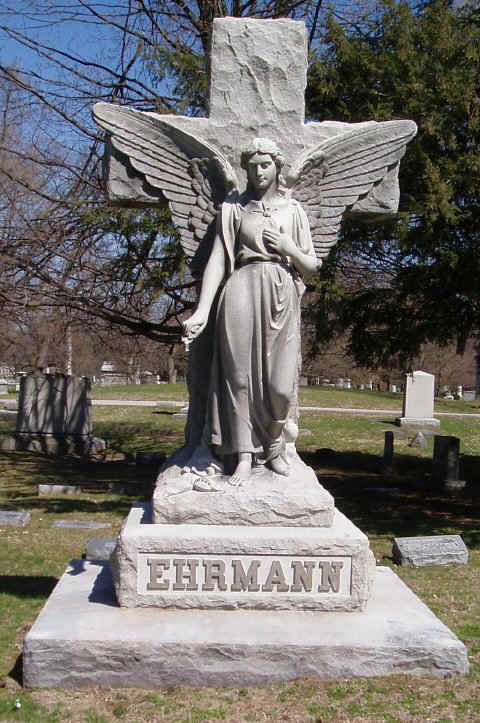
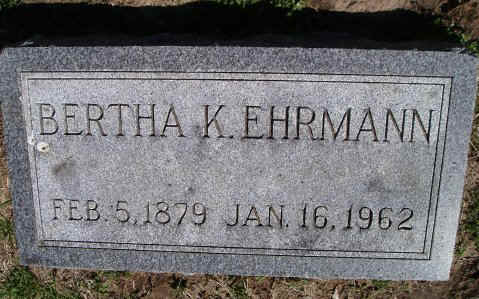
![]()

Bertha Pratt King was born on the 05th February 1879. Her wealthy parents Charles P. King and his wife Sarah (Richmond) King owned a flourishing knitting company and Saxony Mill in Little Falls, New York. Afforded a good early education, she later entered the prestigious women’s college, Smith College in Northampton, Mass. After graduating with a degree in 1901, she became active in the suffragette movement and lectured widely addressing the challenges facing women in the early 1900s.
In
1904 Bertha relocated to Terre Haute as a private tutor to the children of a
prominent family. A year later she
co-founded a private day school with Mary Sinclair Crawford, initially known as
the “King-Crawford Classical School”, it was later renamed the “King
Classical School” in 1916. She also
wrote a book called: The Worth
of a Girl
(published by Thomas Y. Crowell & Co - 1916), in which she highlighted
women’s early equality issues, stating:
“I
believe the solution of every girl’s problem is that, just like her brother,
she should prepare for some useful work. Like the boy when prepared she should
go out and look for a job. Her choice of work is what she likes and what she is
trained for. Men no longer own all the jobs. We know now that all work is human;
that no work belongs to a man because he is a man nor to a woman because she is
a woman. Work belongs to the man or woman who can do it best, and the joy of
reward belongs to that man or woman.”
After the death of her husband Max in 1945, Bertha continued to live in the home they had shared at 524 S. Sixth St, Terre Haute, and dedicated the rest of her life to promoting and republishing his works. In 1948 she published a collection of his poems as: The Poems Of Max Ehrmann, which included the Desiderata, she also wrote his biography: Max Ehrmann: A Poet’s Life (1951), and then edited and published his journals as: The Journal of Max Ehrmann (1952). Bertha died at St. Anthony’s Hospital, Terre Haute on the 16th January 1961, and later laid to rest next to her husband Max at the Highland Lawn Cemetery in Terre Haute (photo above).
![]()
Max Ehrmann’s most famous poem the Desiderata (a
Latin term meaning “things to be desired”) was originally published as Go
Placidly Amid The Noise And Haste, to which the legal copyright
notice was dated the 3rd January 1927 (number 962402). At about the same time, Max wrote a note in his journal
stating: “I should
like, if I could, to leave a humble gift - a bit of chaste prose that had caught
up some noble moods.”
Later in 1933, Max included a copy of the Desiderata
in a Christmas message to his friends, however he failed to append the copyright
notice. One of these eventually
found its way to a Merrill Moore. In 1942, by then a United States Army psychiatrist in World
War II, Moore began to correspond with Max and revealed that he had distributed
some 1,000 copies of the Desiderata while working in civilian practice in
Boston. Further letters between
them revealed that he also requested and received permission from Max to
distribute the Desiderata to soldiers as part of his treatments.
Later in 1944, Moore wrote again, this time from the South Pacific,
stating that he continued to use the poem in his work.
In
a letter dated 20th July 1942, Moore identified himself as a
practicing psychiatrist on active duty with the U.S. Army.
Quoting from his correspondence, “I Think you should know that nearly
every day of my life I use your very fine prose poem Desiderata in my work--here
I have found your philosophy useful and have given away a thousand copies in the
last few years. A patient, a
depressed woman, gave it to me once several years ago with no address
attached---!”
Another
written quote by Moore, “I have distributed the beautiful copies which you
sent me and want to thank you for them again.
I know that I shall carry Desiderata with me when I get there (E.
Indies). I shall have it
multigraphed for distribution to the soldiers if you have no objections.
Ehrmann’s
response in 1942 was: “Yes, of
course, you may distribute multigraphed copies of Desiderata to the soldiers. I am happy to have at least this small part in your splendid
work.” Moore to Ehrmann at
Thanksgiving, November 1944, “Also, I use Desiderata liberally and always find
it helpful. Like a panacea (it
cures everything) it should be bottled and sold as DR. EHRMANN’S MAGIC SOUL
MEDICINE!!! I am continuing to use
your priceless prose poem in my work.”
After Max’s death in 1945, his widow Bertha published
the Desiderata with other works in a collection entitled The Poems Of
Max Ehrmann (1948), at the same time she renewed the copyright notice both
in 1948 and 1954. When Bertha died
in 1962, the copyright and ownership of the Desiderata was bequeathed
to her nephew Richmond Wight, who in turn later sold it for an undisclosed sum
to Robert L. Bell of the Crescendo Publishing Company in 1971.
In 1959 a myth concerning the antiquity of the Desiderata began to circulate when the Reverend Frederick Kates, rector of the Old St. Paul’s Church in Baltimore, Maryland, produced some 200 copies of the poem, together with others, for distribution among his parishioners. However, he reproduced his copies of the poems on Church headed paper monogrammed with “Old St. Paul’s Church, Baltimore A.C. 1692”, the date the Church was founded. This led to the belief that the Desiderata was of the same age. In the years that followed as copies of the Church headed poem was passed on from friend to friend and re-copied, so did the myth and antiquity of the poem prevail.
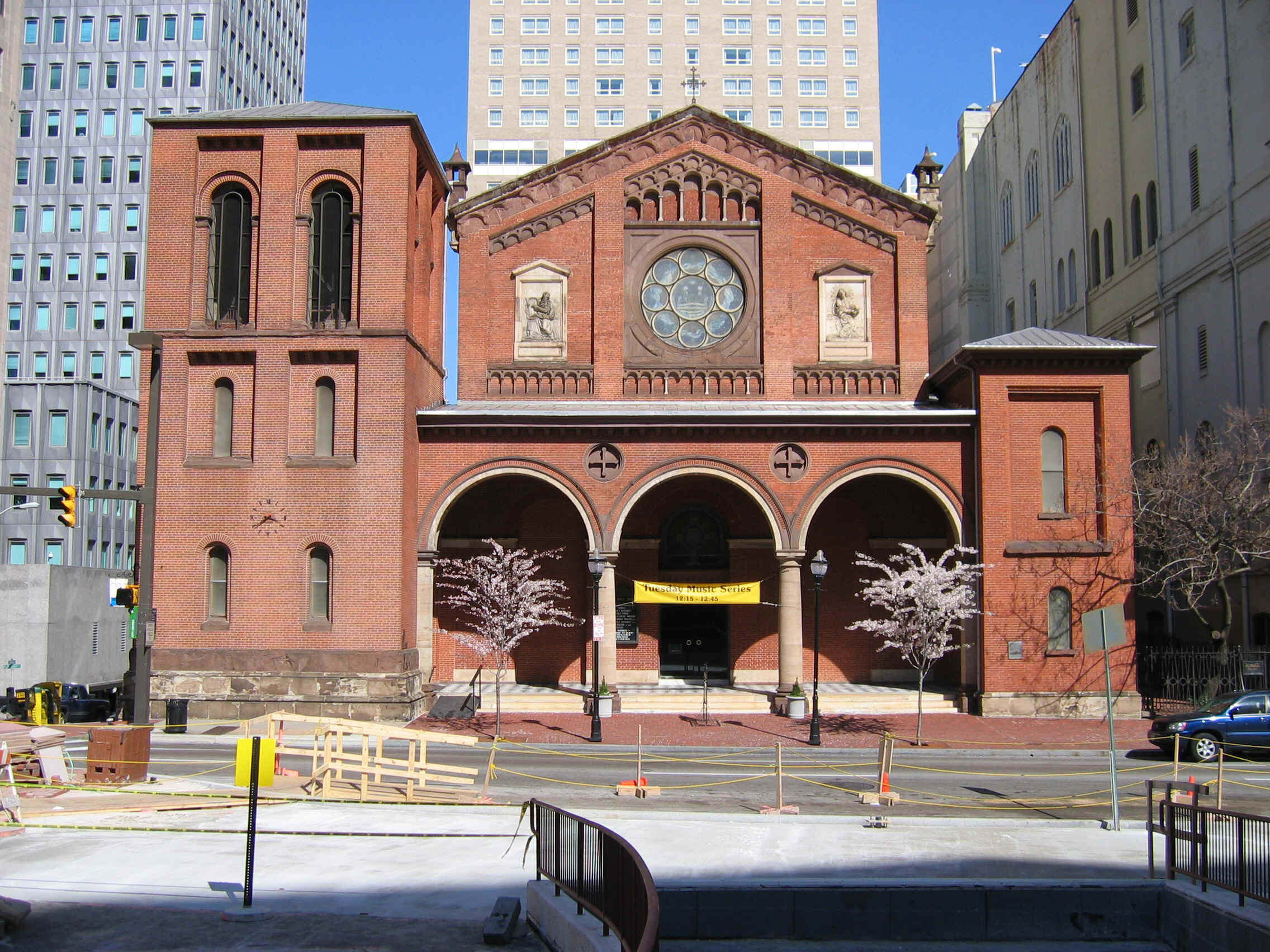
After the death of Adlai Ewing Stevenson on the 14th July 1965 (the 31st Governor of Illinois, and twice the Democratic Party candidate for President in 1952 and 1956), a copy of the “Church headed” Desiderata was found on his bedside table. It is believed he thought it a genuine old poem dated as headed in 1692, and had intended to use it in his Christmas cards later that year. The discovery of the poem and the following publicity further enhanced the fame and myth of the Desiderata, which throughout the late 1960’s was widely distributed as an inspirational lifestyle poem and reproduced on posters, plaques and greeting cards.
Inspired by one such poster, the singer Les Crane used
the words of the Desiderata in his 1971 hit record, for which he received
a Grammy award for the “best spoken word recording.”
It was also re-published in the August 1971 issue of the magazine
Success Unlimited, owned by the Combined Registry Co.
This caused Robert L. Bell, who had earlier bought the copyright from Richmond
Wight, to filed a copyright infringement suit against the Combined
Registry Co. In 1975 the
Federal District Court for the Northern District of Illinois decided in favour
of the Combined Registry Co. Bell
then took the case to 7th Circuit Court of Appeals, but they confirmed the
earlier Courts decision. Bell tried
again, this time at the U.S. Supreme Court, but they declined to hear the case.
The question now remains, is the Desiderata
still in the public domain?
It would appear from their ruling that the U.S. Federal District Court (Bell v. Combined Registry, Co.) supported the fact that in 1942 Max Ehrmann had given Merrill Moore permission to use the Desiderata “gratuitously and without mention of copyright notice”, therefore Ehrmann had forfeited his right to have the copyright protected, and that the “Abandonment of Copyright” decision was valid. Later the U.S. 7th Circuit Court of Appeals also upheld that decision. However, Mr. Bell, owner of the copyright until his death in 2009, did succeed in winning copyright claims in other jurisdictions of the United States. As a result, the singer Les Crane had to pay royalties on his use of the Desiderata. So, beware if you intend to publish it for self-gain or profit?
![]()
In 1937 Max
Ehrmann was awarded a “Doctor of Letters” honorary degree from DePauw
University, and as a member of the University’s “Delta Tau Delta” college
fraternity, he was given the
fraternity’s highest alumni award, and elected to the Distinguished Service
Chapter. This award is only
bestowed on alumni who have been actively loyal to the fraternity for at least
twenty years, rendered some unusual service to the fraternity or division
thereof, and evidenced personal characteristics and habits which have been and
are “worthy of all acceptance” by the fraternity and society at large.
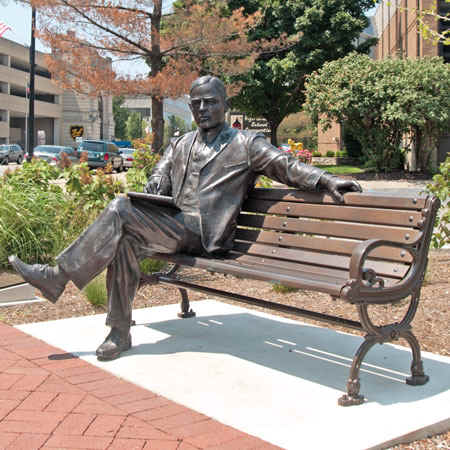
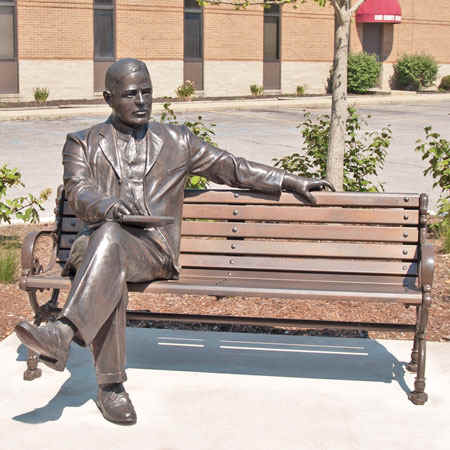
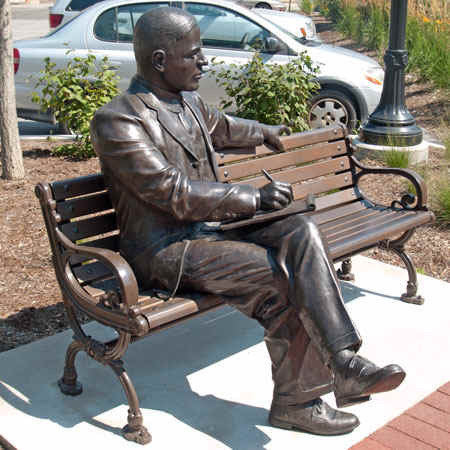
More recently on the 26th August 2010 a sculpture by noted artist Bill Wolfe in honour of Max Ehrmann, the “Poet Laureate of Terre Haute”, was unvailed and dedicated in a public ceremony at Seventh Street and Wabash Avenue (known as the “Crossroads of America”) in Terre Haute. During his life time Max had often sat at this corner to gather inspiration from the city life around him. The bronze life-size sculpture features Max seated on a park bench with pen and paper in hand writing, and excerpts from the Desiderata embedded on plaques in the walkway around it. Another plaque and bench is located at the Poplar Street entrance of the Vigo County Public Library.
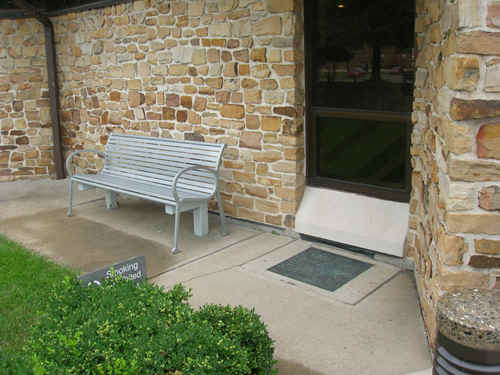
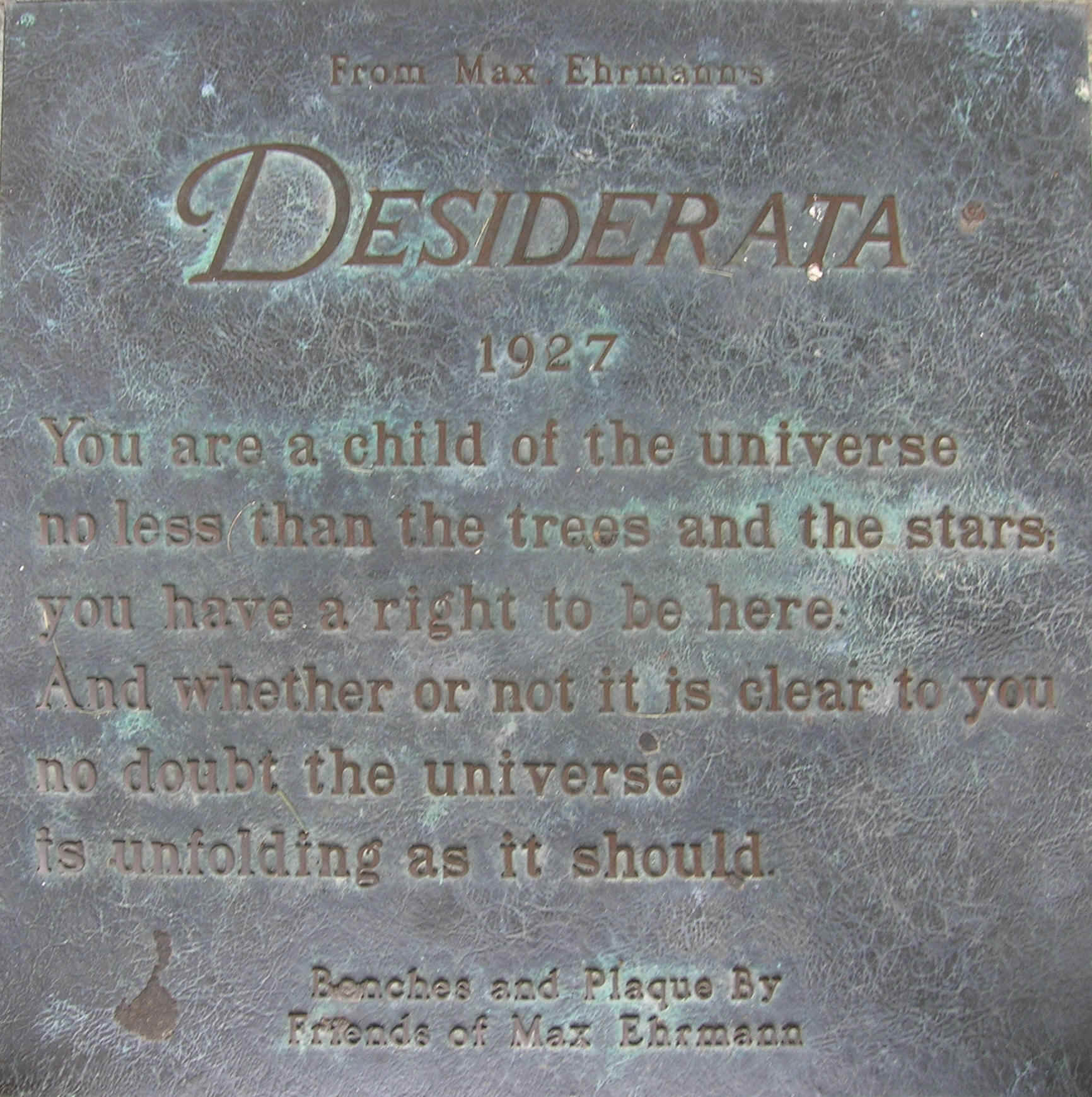
Such is a
fitting tribute, Max Ehrmann himself once stated:
“Perhaps even when I’m dead, some browser in libraries will come
upon me and, seeing that I was not altogether unworthy, will resurrect me from
the dust of things forgotten.”
![]()
![]()
http://en.wikipedia.org/wiki/Max_Ehrmann
http://www.findagrave.com/cgi-bin/fg.cgi?page=gr&GRid=9373789
http://pretendthisiseasy.blogspot.com/2006/02/desiderata-by-max-ehrmann.html
http://www.fleurdelis.com/combinedregistry.htm
http://law.justia.com/cases/federal/appellate-courts/F2/536/164/139671/
http://emilville.com/history.html
http://visions.indstate.edu/cdm4/item_viewer.php?CISOROOT=/vchs&CISOPTR=1031&CISOBOX=1&REC=16
http://wabashvalleyartspaces.com/maxview1.html
http://www.vigo.lib.in.us/archives/genhistories/wabvalrem/pt44.pdf
First published on the 03rd February 2012 © George Knowles

Let there be peace in the world - Where have all the flowers gone?
My Personal Page / My Place in England, UK / My Family Tree (Ancestry)
Wicca/Witchcraft / What is Wicca / What is Magick
Traditional Writings:
Wiccan Rede / Charge of the Goddess / Charge of the God / The Three-Fold Law (includes The Law of Power and The Four Powers of the Magus) / The Witches Chant / The Witches Creed / Descent of the Goddess / Drawing Down the Moon / The Great Rite Invocation / Invocation of the Horned God / The 13 Principles of Wiccan Belief / The Witches Rede of Chivalry / A Pledge to Pagan Spirituality
Correspondence Tables:
Incense / Candles / Colours / Magickal Days / Stones and Gems / Elements and Elementals
Traditions Part 1 - Alexandrian Wicca / Aquarian Tabernacle Church (ATC) / Ár Ndraíocht Féin (ADF) / Blue Star Wicca / British Traditional (Druidic Witchcraft) / Celtic Wicca / Ceremonial Magic / Chaos Magic / Church and School of Wicca / Circle Sanctuary / Covenant of the Goddess (COG) / Covenant of Unitarian Universalist Pagans (CUUPS) / Cyber Wicca / Dianic Wicca / Eclectic Wicca / Feri Wicca /
Traditions Part 2 - Gardnerian Wicca / Georgian Tradition / Henge of Keltria / Hereditary Witchcraft / Hermetic Order of the Golden Dawn (H.O.G.D.) / Kitchen Witch (Hedge Witch) / Minoan Brotherhood and Minoan Sisterhood Tradition / Nordic Paganism / Pagan Federation / Pectic-Wita / Seax-Wica / Shamanism / Solitary / Strega / Sylvan Tradition / Vodoun or Voodoo / Witches League of Public Awareness (WLPA) /
Gods and Goddesses (Greek
Mythology) / Esbats &
Full Moons / Links
to Personal Friends & Resources / Wicca/Witchcraft
Resources / What's a spell? /
Circle Casting and
Sacred Space / Pentagram
- Pentacle / Marks
of a Witch / The Witches
Power / The Witches Hat
/ An
esoteric guide to visiting London / Satanism
/ Pow-wow
/ The
Unitarian Universalist Association / Numerology: Part 1
/ Part 2 / Part
3 / A
history of the Malleus Maleficarum: includes: Pope
Innocent VIII /
The
papal Bull /
The
Malleus Maleficarum /
An extract from the Malleus Maleficarum
/ The letter of approbation
/ Johann
Nider’s Formicarius /
Jacob
Sprenger /
Heinrich Kramer /
Stefano Infessura
/ Montague Summers /
The Waldenses
/ The Albigenses
/
The Hussites / The
Sun Dance
/ Shielding (Occult
and Psychic Protection) /
Sabbats in History and Mythology / Samhain (October 31st) / Yule (December 21st) / Imbolc (February 2nd) / Ostara (March 21st) / Beltane (April 30th) / Litha (June 21st) / Lughnasadh (August 1st) / Mabon (September 21st)
Rituals contributed by Crone: Samhain / Yule / Imbolc / Ostara / Beltane / Litha / Lammas / Mabon
Tools of a Witch / The Besom (Broom) / Poppets and Dolls / Pendulums / Cauldron Magick / Mirror Gazing
Animals in Witchcraft (The Witches Familiar) / Antelope / Bats / Crow / Fox / Frog and Toads / Goat / Honeybee / Kangaroo / Lion / Owl / Phoenix / Rabbits and Hares / Raven / Robin Redbreast / Sheep / Spider / Squirrel / Swans / Wild Boar / Wolf / Serpent / Pig / Stag / Horse / Mouse / Cat
In Worship of Trees - Myths, Lore and the Celtic Tree Calendar. For descriptions and correspondences of the thirteen sacred trees of Wicca/Witchcraft see the following: Birch / Rowan / Ash / Alder / Willow / Hawthorn / Oak / Holly / Hazel / Vine / Ivy / Reed / Elder. Also see: The Willow Tree (Folk Music)
Mystical Sacred Sites - Stonehenge / Glastonbury Tor / Malta - The Hypogeum of Hal Saflieni / Avebury / Cerne Abbas - The Chalk Giant / Ireland - Newgrange /
Rocks and Stones:
Stones - History, Myths and Lore
Articles contributed by Patricia Jean Martin: / Apophyllite / Amber / Amethyst / Aquamarine / Aragonite / Aventurine / Black Tourmaline / Bloodstone / Calcite / Carnelian / Celestite / Citrine / Chrysanthemum Stone / Diamond / Emerald / Fluorite / Garnet / Hematite / Herkimer Diamond / Labradorite / Lapis Lazuli / Malachite / Moonstone / Obsidian / Opal / Pyrite / Quartz (Rock Crystal) / Rose Quartz / Ruby / Selenite / Seraphinite / Silver and Gold / Smoky Quartz / Sodalite / Sunstone / Thunderegg / Tree Agate / Zebra Marble
Wisdom:
Knowledge vs Wisdom by Ardriana Cahill / I Talk to the Trees / Awakening / The Witch in You / A Tale of the Woods
Articles and Stories about Witchcraft:
Murder by Witchcraft / The Fairy Witch of Clonmel / A Battleship, U-boat, and a Witch / The Troll-Tear (A story for Children) / Goody Hawkins - The Wise Goodwife / The Story of Jack-O-Lantern / The Murder of the Hammersmith Ghost / Josephine Gray (The Infamous Black Widow) / The Two Brothers - Light and Dark
Old Masters of Academia:
Pliny the Elder / Hesiod / Pythagoras
Abramelin the Mage / Agrippa / Aidan A. Kelly / Albertus Magnus “Albert the Great” / Aleister Crowley “The Great Beast” / Alex Sanders "the King of the Witches” / Alison Harlow / Amber K / Anna Franklin / Anodea Judith / Anton Szandor LaVey / Arnold Crowther / Arthur Edward Waite / Austin Osman Spare / Biddy Early / Bridget Cleary / Carl Llewellyn Weschcke / Cecil Hugh Williamson / Charles Godfrey Leland / Charles Walton / Christina Oakley Harrington / Damh the Bard (Dave Smith) / Dion Fortune / Dolores Aschroft-Nowicki / Dorothy Morrison / Doreen Valiente / Edward Fitch / Eleanor Ray Bone “Matriarch of British Witchcraft” / Dr. John Dee and Edward Kelly / Dr. Leo Louis Martello / Eliphas Levi / Ernest Thompson Seton / Ernest Westlake and the Order of Woodcraft Chivalry / Fiona Horne / Friedrich von Spee / Francis Barrett / Gerald B. Gardner / Gavin and Yvonne Frost and the School and Church of Wicca / Gwydion Pendderwen / Hans Holzer / Helen Duncan / Herman Slater "Horrible Herman" / Israel Regardie / James "Cunning" Murrell / Janet Farrar & Gavin Bone / Jessie Wicker Bell “Lady Sheba” / John Belham-Payne / John George Hohman / John Gerard / John Gordon Hargrave (the White Fox) / John Michael Greer / John Score / Johannes Junius the Burgomaster of Bamberg / Joseph John Campbell / Karl von Eckartshausen / Laurie Cabot "the Official Witch of Salem" / Lewis Spence / Margaret Alice Murray / Margot Adler / Marie Laveau the " Voodoo Queen of New Orleans" / Marion Weinstein / Matthew Hopkins “The Witch-Finder General” / Max Ehrmann and the Desiderata / Monique Wilson the “Queen of the Witches” / Montague Summers / Nicholas Culpeper / Nicholas Remy / M. R. Sellers / Mrs. Grieve "A Modern Herbal" / Oberon and Morning Glory Zell-Ravenheart / Old Dorothy Clutterbuck / Old George Pickingill / Paddy Slade / Pamela Colman-Smith / Paracelsus / Patricia Crowther / Patricia Monaghan / Patricia “Trish” Telesco / Philip Emmons Isaac Bonewits / Philip Heselton / Raymond Buckland / Reginald Scot / Robert Cochrane / Robert ‘von Ranke’ Graves and "The White Goddess" /
Rudolf Steiner / Rosaleen Norton “The Witch of Kings Cross” / Ross Nichols and The Order of Bards, Ovates & Druids / Sabrina - The Ink Witch / Scott Cunningham / Selena Fox / Silver Ravenwolf / Sir Francis Dashwood / Sir James George Frazer / S.L. MacGregor Mathers and the “Hermetic Order of the Golden Dawn” / Starhawk / Stewart Farrar / Sybil Leek / Ted Andrews / The Mather Family - includes: Richard Mather, Increase Mather, Cotton Mather / Thomas Ady / Vera Chapman / Victor Henry Anderson / Vivianne Crowley / Walter Brown Gibson / William Butler Yeats / Zsuzsanna Budapest
Many of the above biographies are brief and far from complete. If you know about any of these individuals and can help with aditional information, please cantact me privately at my email address below. Many thanks for reading :-)
While I have taken due care and dilligence to credit all sources where possible, this website may contain copyrighted material which has not been specifically authorized by the copyright owner. My use of making such material available here is done so in my efforts to advance our understanding of religious discrimination, the environmental and social justice issues etc. If you wish to use copyrighted material from this wedsite for purposes of your own then you must obtain permission from the relevant copyright owner yourself.
![]()
My online email discussion group:
http://groups.yahoo.com/group/Email_Witches

Help send a message of peace around the world! The Dove of Peace flies from site to site, through as many countries as possible. It does not belong to ANY belief system. Please help make a line around the globe by taking it with you to your site, by giving it to someone for their site, by passing it on to another continent or to the conflict areas of the world. May trouble and strife be vanquished in it's path.

mailto:George@controverscial.com
![]()
|
|